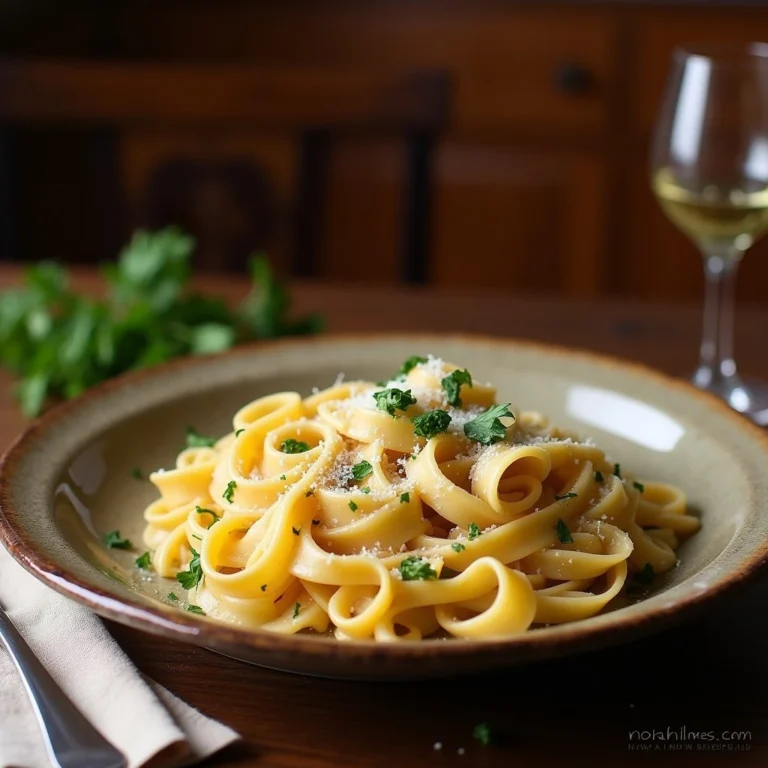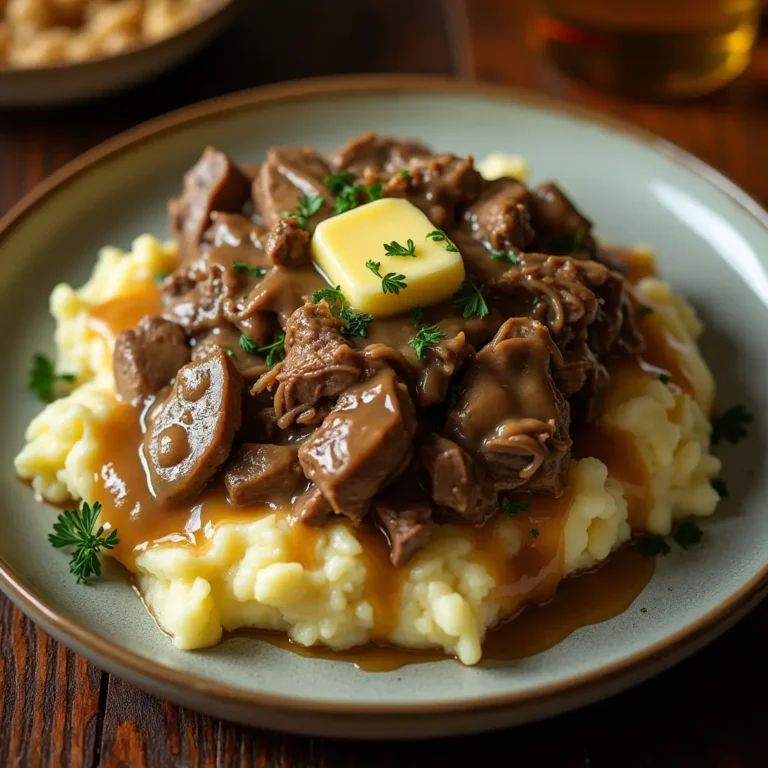Delicious Mongolian Beef Recipe
Our Mongolian Beef dish has become a favorite in many homes since we shared the easy Mongolian Beef recipe in July 2015. It’s easy to see why it’s a top pick on our site. The taste is delicious and it’s simple to make.
This beloved recipe is loved by all and is quick to prepare. It’s great for any night of the week or for special events. With just a few simple ingredients and easy instructions, you’ll be enjoying it in no time.
Key Takeaways
- Quick and easy preparation
- Delicious flavor profile
- Perfect for weeknight dinners or special occasions
- Simple ingredients
- Easy-to-follow instructions
What is Mongolian Beef?
Mongolian Beef is not from Mongolia but a mix of Chinese and American cooking. In Mongolia, people usually boil meat and add sauces. This is different from the stir-fry dish known as Mongolian Beef in the U.S.
Origins and History
The origins of Mongolian Beef are complex. It was influenced by Chinese cooking and adapted for American tastes. It’s believed to have been made in the U.S. as a Chinese cooking representation, not an authentic Mongolian or Chinese dish.
Traditional vs. American-Chinese Versions
Traditional Mongolian cooking boils or steams meat. But the American-Chinese version of Mongolian Beef is a stir-fry. It uses sliced beef, like flank steak, and a savory sauce. The main differences are in cooking methods and sauce ingredients.
- Traditional Mongolian cuisine: Boiling or steaming meat.
- American-Chinese Mongolian Beef: Stir-frying sliced beef with a savory sauce.
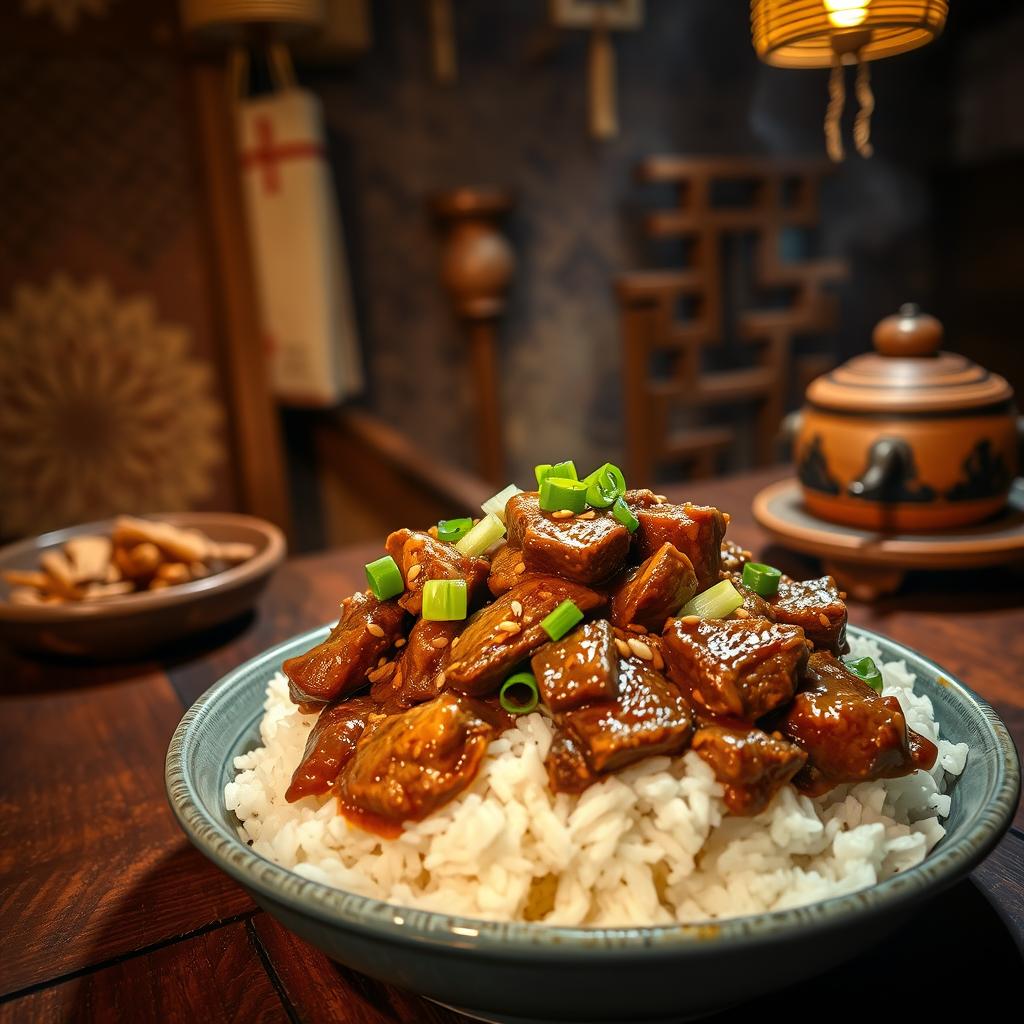
Why This Mongolian Beef Recipe Stands Out
Our Mongolian Beef recipe is special because it has the perfect mix of flavors and is easy to make. It’s a favorite in Chinese-American cuisine. People love it for its savory, slightly sweet taste and tender beef.
Flavor Profile
The flavors in our Mongolian Beef are rich and complex. We use soy sauce, hoisin sauce, and a bit of ginger. By using less sugar and oil, we made it healthier and more flavorful. The sauce sticks to the beef, making every bite a delight.

Ease of Preparation
This recipe is easy to make, which is a big plus. You need simple ingredients and just a few steps to get it ready. You can even marinate the beef ahead of time. The sauce is quick to make, making it great for a weeknight dinner.
Here’s why this recipe is a hit:
| Feature | Benefit |
|---|---|
| Rich Flavor Profile | Complex, savory taste with less sugar and oil |
| Easy Preparation | Simple ingredients, straightforward steps |
Essential Ingredients for Authentic Mongolian Beef
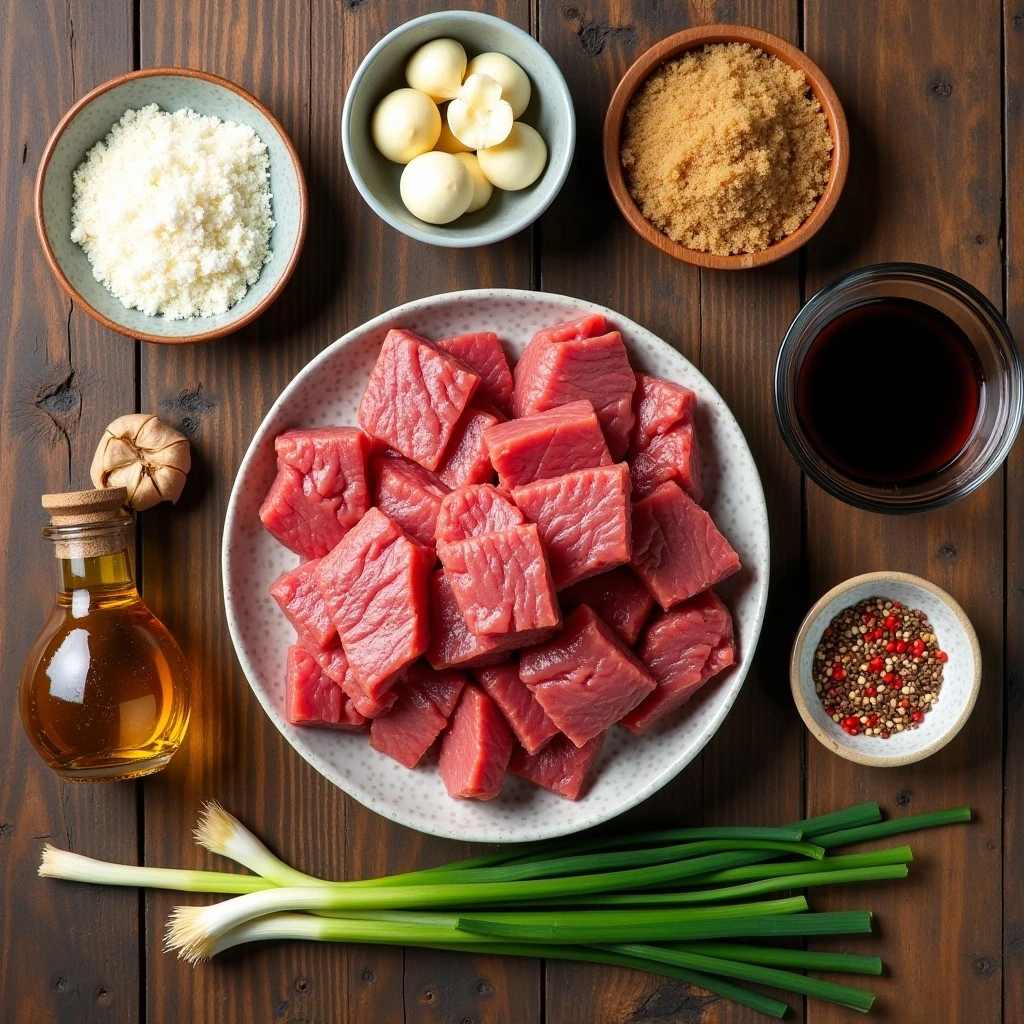
To make Mongolian beef that’s both flavorful and authentic, you’ll need to choose the right ingredients. The dish’s taste and texture depend on quality beef, the right sauce, and fresh veggies.
Selecting the Right Cut of Beef
Choosing the right cut of beef is key for tender and flavorful Mongolian beef. Flank steak is often used because it’s lean and absorbs marinades well.
Flank Steak vs. Other Cuts
While flank steak is traditional, other cuts like skirt steak or sirloin can also work. But flank steak is the top choice for its texture and taste.
Quality Indicators to Look For
When picking beef, look for good marbling for tenderness and flavor. The beef should feel firm and have a fresh, red color.
Key Sauce Components
The sauce is crucial for Mongolian beef, adding a rich, savory flavor. It includes soy sauce, sweeteners, and aromatics.
Soy Sauce Selection
Light soy sauce is best for its salty taste and umami boost. Choose a high-quality soy sauce for the best flavor.
Sweeteners and Their Impact
Sweeteners like hoisin sauce or brown sugar add depth and balance. They make the sauce thicker and richer.
Essential Aromatics
Aromatics like garlic and ginger are key for the dish’s aroma. They’re minced and sautéed to release their flavors.
Vegetables and Garnishes
Vegetables like bell peppers and scallions add color, texture, and freshness. They’re stir-fried with the beef and sauce.

By focusing on these essential ingredients, you can make a delicious Mongolian beef dish. The quality of your ingredients greatly affects the final taste, so choose the best you can find.
Kitchen Tools You’ll Need
Having the right kitchen tools is key to making tasty Mongolian Beef. The right tools make cooking smoother and help the dish taste authentic.
Essential Equipment
You’ll need a few important pieces of cooking equipment. The most critical tool is a wok or a large frying pan. When choosing, think about the following:
Wok vs. Frying Pan Considerations
A wok is best for Mongolian Beef because of its shape. It cooks ingredients quickly and evenly. But, a large frying pan works too if you don’t have a wok. The important thing is to have enough room to stir-fry fast over high heat, like in the recipe where 2/3 cup neutral oil is heated in a wok over high heat.
Knife Selection for Proper Slicing
A sharp knife is also essential for slicing beef thinly and evenly. A good knife selection greatly affects the texture of your Mongolian Beef. Choose a knife that’s sharp and easy to hold.
Optional but Helpful Tools
While not essential, some extra tools can make prep easier. You might want a cutting board for chopping, a measuring jug for the sauce, and tongs or a spatula for stir-frying. Having these tools can improve your cooking experience.
Preparing the Beef

To make tender and flavorful Mongolian Beef, you need to prepare it right. This means following a few key steps. These steps will help your dish taste great and be true to its roots.
Slicing Techniques for Tender Results
First, you must slice the beef correctly for tender Mongolian Beef. It’s important to know the meat’s grain and slice it right.
Cutting Against the Grain
Cutting against the grain means slicing the beef at a right angle to the muscle lines. This makes the beef tender and easy to chew.
Ideal Thickness for Quick Cooking
The beef should be sliced thin, about ¼ inch. This thinness helps it cook fast and stay tender.
Marinating Process
Marinating the beef is key to better flavor and tenderness. A good marinade includes soy sauce, garlic, and ginger. Slice the flank steak into thin ¼” pieces, toss with cornstarch, shake off excess, and set aside.
| Marinade Ingredient | Purpose |
|---|---|
| Soy Sauce | Adds umami flavor |
| Garlic | Enhances aroma |
| Ginger | Provides a warm, spicy flavor |
Velveting Method for Restaurant-Quality Texture
The velveting method coats the beef in cornstarch, egg whites, and sometimes soy sauce before cooking. This method makes the beef smooth and velvety, just like in restaurants.
“The velveting technique is a game-changer for home cooks looking to achieve that authentic, silky texture in their Mongolian Beef.”
By following these steps, you’ll make a delicious and authentic Mongolian Beef dish.
Creating the Perfect Mongolian Sauce
The secret to a great Mongolian beef dish is its sauce. It’s a mix of sweet, savory, and spicy flavors. This sauce turns a simple stir-fry into a memorable meal. We’ll show you how to make this special sauce.
Base Sauce Ingredients
To start, mix hot water or stock, brown sugar, light soy sauce, and dark soy sauce in a bowl. Dissolving the brown sugar in hot water makes the sauce smooth. The light and dark soy sauces add depth and umami.
Balancing Sweet and Savory Flavors
It’s important to balance sweet and savory. Brown sugar adds sweetness, while soy sauces bring savory flavors. You can adjust the sugar or soy sauce to your liking.
Adjusting Heat Levels
If you like a little heat, add chili peppers or flakes. For a milder sauce, use less or none of these.
Chili Options for Different Spice Preferences
Choosing different chilies lets you control the heat. Szechuan peppercorns add a unique heat, while jalapeños are sharper.
Non-Spicy Alternatives
For a non-spicy sauce, skip the chili and focus on sweet and savory. This makes the dish more for everyone.
| Ingredient | Function | Adjustment for Taste |
|---|---|---|
| Brown Sugar | Adds sweetness | Increase for sweeter, decrease for less sweet |
| Soy Sauce | Provides savory/umami flavor | Adjust to taste for saltiness and depth |
| Chili Peppers/Flakes | Adds heat | Omit or reduce for less heat, increase for more |
By balancing these elements, you can make a Mongolian sauce that enhances your beef and vegetables. Your dish will be unforgettable.
Step-by-Step Mongolian Beef Recipe
Here’s a simple guide to making delicious Mongolian Beef at home. This recipe is easy to follow. Even novice cooks can get professional results.
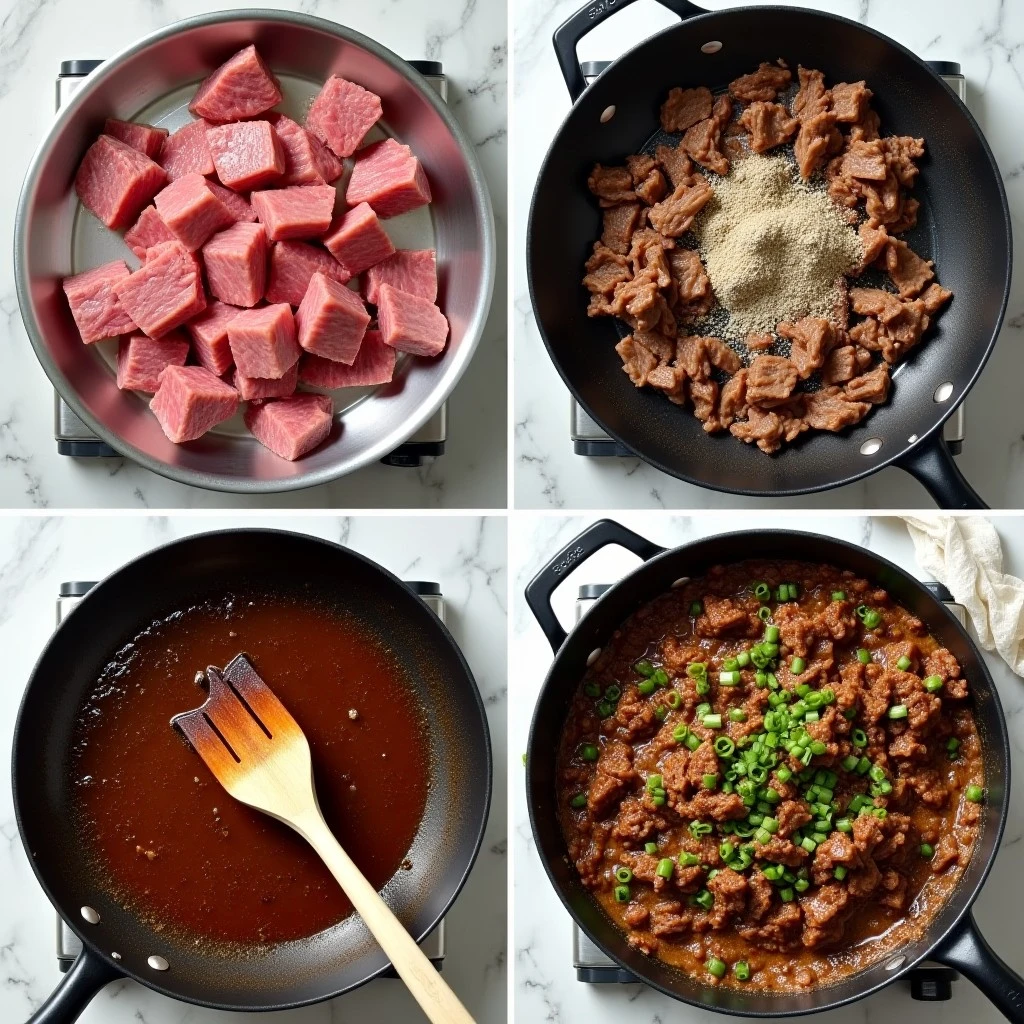
Preparing the Ingredients
Before cooking, have all ingredients ready. This is called mise en place.
Mise en Place Organization
Organizing ingredients in advance makes cooking easier and less stressful. Slice the beef thinly and chop your vegetables.
Time-Saving Prep Tips
Prep ingredients a day ahead to save time. Store them in airtight containers in the fridge to keep them fresh.
Cooking the Beef
Cooking the beef right is key. Here’s how to do it.
Proper Oil Temperature
Heat 2/3 cup of neutral oil in a wok over high heat. It’s ready when it shimmers. This helps get a good sear on the beef.
Batch Cooking for Best Results
Cook the beef in batches to avoid overcrowding. This ensures even cooking.
Visual Cues for Doneness
Cook the flank steak for 1 minute on each side. They’re done when nicely browned. Use visual cues to check for doneness, as overcooking can make the beef tough.
Combining with Sauce and Vegetables
Once your beef is cooked, mix it with the sauce and vegetables.
Timing for Adding Components
Add the vegetables to the wok and stir-fry for a minute. Then, pour in the Mongolian sauce. Stir everything together to coat the beef and vegetables evenly.
Thickening the Sauce Properly
If the sauce needs thickening, mix a little cornstarch with water and add it to the sauce. Stir constantly until the sauce reaches your desired consistency.
| Component | Cooking Time | Tips |
|---|---|---|
| Beef | 1 minute/side | Cook in batches for even cooking |
| Vegetables | 1 minute | Stir-fry quickly to preserve crunch |
| Sauce | Until thickened | Stir constantly to avoid lumps |
Common Mistakes to Avoid
To make perfect Mongolian Beef, you must avoid a few common errors. This dish is easy to make, but some mistakes can spoil it. Knowing these mistakes helps ensure a tasty and fulfilling meal.
Overcooking the Beef
One big mistake is overcooking the beef. Overcooking makes the beef tough and dry, which is not good. To fix this, cook the beef quickly over high heat and take it off the heat when it’s just done. Also, slice the beef thinly against the grain to keep it tender.
Sauce Consistency Issues
Getting the sauce right is another challenge. If the sauce is too thick, it’s overpowering; too thin, and it won’t stick to the beef. Adjusting cornstarch or cooking time can solve this. Always stir the sauce constantly to avoid lumps.
Flavor Balance Problems
Flavor balance is key in Mongolian Beef. Too much soy sauce makes it too salty, too little, and it lacks depth. Tasting and adjusting as you go is crucial. The sauce should be savory, slightly sweet, and spicy.
| Mistake | Consequence | Solution |
|---|---|---|
| Overcooking the beef | Tough and dry beef | Cook quickly over high heat, slice thinly against the grain |
| Incorrect sauce consistency | Overpowering or ineffective sauce | Adjust cornstarch, cooking time, and stir constantly |
| Imbalanced flavors | Too salty, too bland, or lacking depth | Taste and adjust seasoning as you go |
Variations of the Best Mongolian Beef Recipe
Mongolian Beef can be made to your liking, whether you love spice or prefer healthy options. Its flexibility is why it’s so popular. You can change a few ingredients or cooking methods to make it just right for you.
Spicy Mongolian Beef
For a spicy twist, add ¼ teaspoon of red pepper flakes. This adds a bold flavor that pairs well with the beef and sauce. You can adjust the heat by adding more or less flakes.
Vegetable-Heavy Versions
Adding colorful veggies not only adds texture but also boosts nutrition. Try adding bell peppers, broccoli, or snap peas for a vegetable-heavy version. These veggies enhance the flavor and make the dish more satisfying.
Low-Carb and Keto-Friendly Adaptations
For low-carb or keto diets, serve Mongolian Beef over cauliflower rice or zucchini noodles. You can also add more veggies and reduce sugar in the sauce. These changes help you enjoy the dish while sticking to your diet.
Exploring these variations keeps Mongolian Beef exciting, even after many meals. Its flexibility makes it perfect for those who love to cook and try new flavors.
Serving Suggestions
Mongolian Beef is not just about the taste; presentation matters too. Serving it correctly can elevate the dining experience and make it more enjoyable for everyone.
Traditional Accompaniments
Traditional accompaniments play a crucial role in complementing the flavors of Mongolian Beef. The right side dishes can enhance the overall dining experience.
Rice Options
Steamed rice is a classic choice to pair with Mongolian Beef. You can also consider:
- Garlic Fried Rice: Adds an extra layer of flavor.
- Jasmine Rice: Offers a fragrant and fluffy texture.
Noodle Pairings
Noodles can also be a great accompaniment. Try pairing your Mongolian Beef with:
- Lo Mein: Stir-fried noodles that soak up the savory sauce.
- Rice Noodles: Light and refreshing, perfect for balancing the richness.
Modern Pairing Ideas
For a modern twist, consider pairing Mongolian Beef with:
- Roasted Vegetables: Adds a nice contrast in texture.
- Steamed Broccoli or Red Bell Pepper Strips: Provides a crunchy and healthy side dish.
Presentation Tips for Impressive Meals
Presentation is key to making your meal impressive. Here are some tips:
- Garnish with Green Onions: Adds a pop of color and freshness.
- Use a Decorative Plate: Enhances the visual appeal of the dish.
- Arrange Ingredients Thoughtfully: Create a visually appealing composition.
By following these serving suggestions, you can turn your Mongolian Beef into a feast for the eyes as well as the taste buds.
Make-Ahead and Storage Tips
Enjoying a homemade Mongolian Beef dinner on a busy night is easier with prep work. Preparing some parts ahead of time cuts down cooking time on serving day.
Preparing Components in Advance
Breaking down the prep into tasks makes cooking Mongolian Beef easy. Focus on the beef marinade and sauce ahead of time.
Marinating Timeline
Marinate the beef up to a day before. Longer marinating times can make the flavor better. Keep it in the fridge until cooking time.
Pre-Making Sauce
Make the Mongolian Beef sauce up to 3 days before. Store it in the fridge. This lets the flavors blend for a richer taste.
Proper Storage and Reheating
Proper storage keeps leftovers tasty. Here’s how to store and reheat.
Refrigeration Guidelines
Keep leftovers in a covered container for up to 4 days. Reheat in the microwave or on the stovetop. Use short intervals in the microwave and stir often on the stovetop.
Freezing Options
Freeze Mongolian Beef for up to 4 months. Use an airtight container or freezer bag to avoid freezer burn. Thaw overnight in the fridge and then reheat as usual.
| Storage Method | Duration | Reheating Method |
|---|---|---|
| Refrigeration | Up to 4 days | Microwave or Stovetop |
| Freezing | Up to 4 months | Thaw overnight, then Microwave or Stovetop |
Conclusion
This Mongolian Beef recipe is a crispy homemade version. It’s less sweet and more flavorful than what you might find in restaurants. By following the steps in this article, you can make a dish that’s both delicious and looks great.
The secret to this recipe’s success is its balance of flavors and textures. It has a savory sauce, tender beef, and crunchy vegetables. This mix makes it a hit in any home.
In short, this Mongolian Beef recipe gives a fresh take on a classic dish. Using top-notch ingredients and the cooking methods we suggest, you can make a meal that rivals those in restaurants. It’s sure to wow your guests.
Now that you’ve read to the end, we invite you to try this Mongolian Beef recipe. It’s easy to make and packed with bold flavors. It’s going to be a favorite in your kitchen for sure.
FAQ
What is Mongolian Beef, and how does it differ from traditional Mongolian cuisine?
Mongolian Beef is a Chinese-American dish, not from Mongolia. It’s made with beef, veggies, and a tasty sauce. It’s different from Mongolian food.
What cut of beef is best for Mongolian Beef?
Use tender beef like flank steak or sirloin. Slice it thinly for the best taste.
Can I make Mongolian Beef ahead of time?
Yes, prep the beef and sauce ahead. It makes cooking quicker and easier.
How do I achieve a restaurant-quality texture for the beef?
Use the velveting method. Coat the beef in cornstarch, egg whites, and seasonings for a tender texture.
What are some common mistakes to avoid when making Mongolian Beef?
Avoid overcooking the beef and sauce issues. Follow the recipe and adjust seasoning to get it right.
Can I make a spicy version of Mongolian Beef?
Yes, add more red pepper flakes or hot sauce for spice. Adjust to your taste.
How do I store and reheat leftover Mongolian Beef?
Keep leftovers in a sealed container for 3 days. Reheat in a pan with a bit of water or broth.
What are some serving suggestions for Mongolian Beef?
Serve it over rice or noodles. Add roasted veggies or a salad for a complete meal.
Can I make a low-carb or keto-friendly version of Mongolian Beef?
Yes, use cauliflower rice or zucchini noodles instead of regular rice. Watch the sauce ingredients too.
How do I balance sweet and savory flavors in the Mongolian sauce?
Adjust soy sauce, hoisin sauce, and sugar. Find the right mix for a balanced flavor.
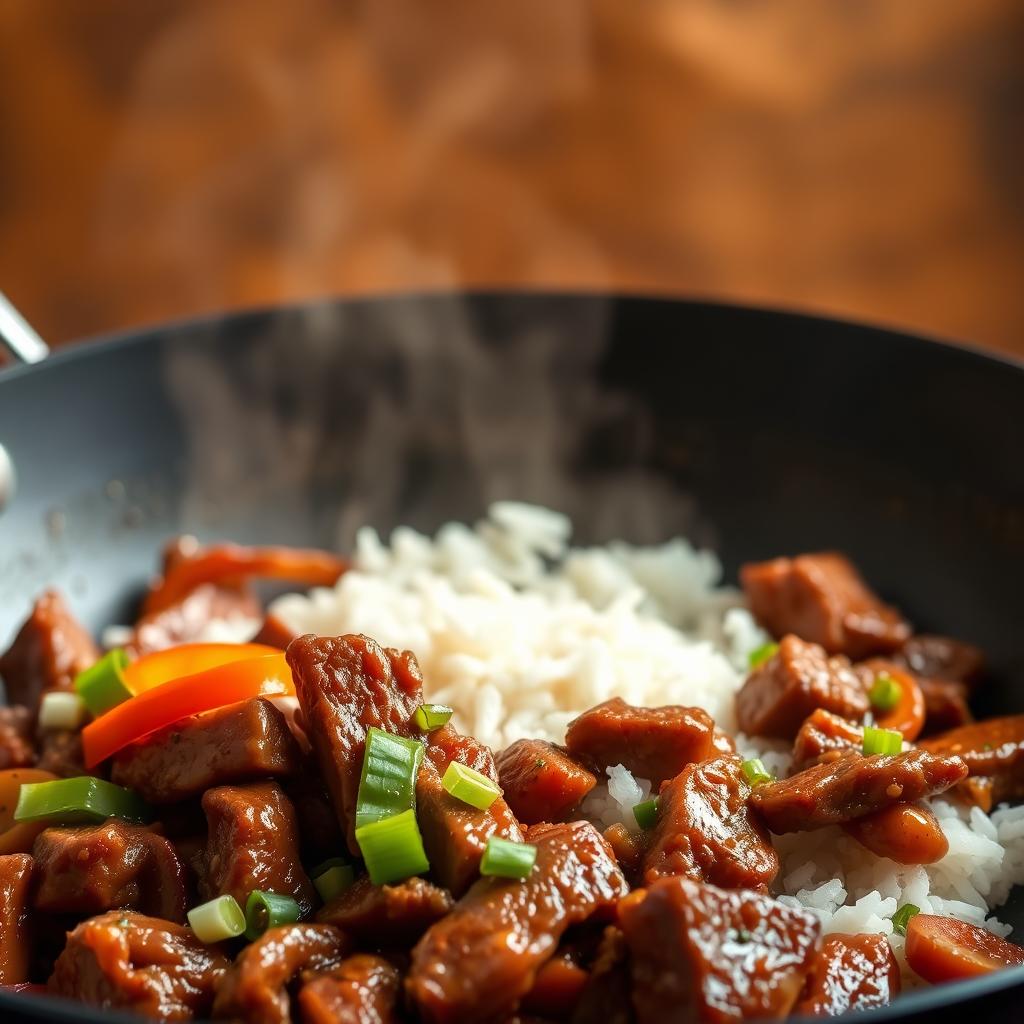
Delicious Mongolian Beef Recipe
Ingredients
Method
- Prepare the beef: Place the sliced flank steak in a bowl and toss with cornstarch. Let sit for 5 minutes to help it crisp when frying.
- Heat the oil: In a large pan or wok, heat the vegetable oil over medium-high heat.
- Cook the beef: Fry the beef in batches (don’t overcrowd the pan) for 2-3 minutes per side until crispy and brown. Remove and set aside.
- Make the sauce: In the same pan, reduce heat to medium and add garlic and ginger. Cook for 30 seconds. Add soy sauce, brown sugar, water, and red pepper flakes. Stir and simmer for 2-3 minutes until slightly thickened.
- Combine: Return the beef to the pan and toss in the sauce until well coated. Cook for another 2 minutes.
- Garnish: Sprinkle with green onions and sesame seeds. Serve hot over steamed rice or noodles
Notes
- Flank steak works best, but you can substitute with sirloin or skirt steak.
- For a healthier version, reduce the sugar to 1/3 cup and use olive oil.
- Leftovers keep well refrigerated for 2 days.
- Gluten-free option: Use tamari instead of soy sauce.


